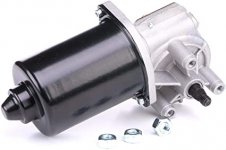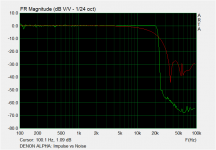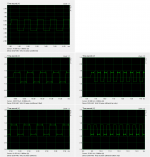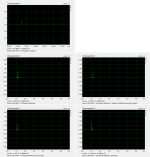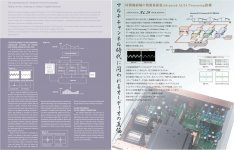How does someone even list something like that on Poshmark? I followed the link, but was unable to navigate to any similar items. There doesnt seem to be a relevant catagory at all...
I have found some items of interest to me listed in the strangest places. It is often someone inherited or otherwise came upon something they realized was of value, but otherwise had no idea as to what it was or actual worth. So they post it on a website more to their tastes.
First time I saw an example it was a high end HP test system priced so low I thought it was a scam. So I didn’t bid on it. The fellow who got it for literally pennies on the dollar gave a very nice review!
Howie,
Just because it is old to you doesn't mean it has no value. I think you can sell some of the old stuff and it will more than pay for a modern replacement.
Just because it is old to you doesn't mean it has no value. I think you can sell some of the old stuff and it will more than pay for a modern replacement.
sigh. know what you mean..I tried to breed apprentices but they all ended up leaving home and getting jobs elsewhere 😀
Two chances left as the lead time is long...
My two youngest decided in high school to run hurdles like I did...they eventually moved on.
I recently found a video of Edwin Moses (two time gold medal, world record) running a race, and I screenshot the 8th hurdle, Edwin in front of course, but me in lane 1, the only evidence I did anything....sent it to my kids..
not 60 seconds later..two texts...
"wow"
"send us the youtube link so we can see you eating his dust..."
Sigh, kids...the great equalizers..
I thought I was the windshield, but nooooo... I was indeed the bug.
How is your daughter doing in her chosen discipline?
jn
simon7000 said: Just because it is old to you doesn't mean it has no value. I think you can sell some of the old stuff and it will more than pay for a modern replacement.
For sure Ed, but I am having trouble finding the time just to get work and home chores done (ask my wife...). This last week alone I spent a good day's work total fixing Husq. ZTR mower, 20 yr old Stihl trimmer and irrigation system. The dream of selling older equipment stays just that for now...of course I guess I could post a list here, I have a bunch of old Tek and other equipment. I am actually re-purposing an Tek 5006 frame with a SG5010, AA5001, and DM5010 (my workhorses for years) to mfg. QC duty at a friend's place...so that's one bulky piece of gear gone...but boy that stuff was state-of-the-art 30 years ago, it's specs are still respectable!
Now if I could get rid of the Tek 5000 & 7000 scope frames and plug ins...I was mentoring (in ham radio speak: Elmering) a young ham a few years back and though I would gift him a nice test setup, but in Uni. he decided against EE and went into Comp.Sci. instead and is now making (as they say) bank. ahh well...
Cheers!
Howie
For sure Ed, but I am having trouble finding the time just to get work and home chores done (ask my wife...). This last week alone I spent a good day's work total fixing Husq. ZTR mower, 20 yr old Stihl trimmer and irrigation system. The dream of selling older equipment stays just that for now...of course I guess I could post a list here, I have a bunch of old Tek and other equipment. I am actually re-purposing an Tek 5006 frame with a SG5010, AA5001, and DM5010 (my workhorses for years) to mfg. QC duty at a friend's place...so that's one bulky piece of gear gone...but boy that stuff was state-of-the-art 30 years ago, it's specs are still respectable!
Now if I could get rid of the Tek 5000 & 7000 scope frames and plug ins...I was mentoring (in ham radio speak: Elmering) a young ham a few years back and though I would gift him a nice test setup, but in Uni. he decided against EE and went into Comp.Sci. instead and is now making (as they say) bank. ahh well...
Cheers!
Howie
The problem with selling the older big Tek stuff is its size. A 7000 mainframe on a cart is too big for anything but freight. And that is a big hassle (and expensive for a one off experience).
Still , I have 2 7854's that need new homes along with a lot of other overkill.
Still , I have 2 7854's that need new homes along with a lot of other overkill.
If you need Bruel & Kjaer on the box to impress this is a really good deal: Bruel & Kjaer 2230 Precision Sound Level Meter with 4155 Microphone 1625 Filter | eBay $310 + shipping.
It's no dishonour to have come second to someone like that!I recently found a video of Edwin Moses
Saw them over the summer. It's reached the point where the science is good but there are problems with the intended application. Not unlike the hard drive technology that needs a laser to erase the phase change they are after works great one way, but needs a huge amount of energy to go back again (as in laser or stick it in an oven). More research needed. But a happy camper has returned with a new sleeve tattoo of the norse wolf Fenrir. Kids of today!How is your daughter doing in her chosen discipline?
They've just gone back after being in UK for a few weeks. I was asked to do a laptop fix. Fix 1 was easy (and hooray for Deoxit). Fix two was one of the two battery packs. Glued in under a glued on panel under the keyboard. I pointed out that the lab in France will have better trained techs with better tools who would stand a far greater change of success.
Talking of fixing has anyone been dumb/stubborn enough to try and fix a screen wiper motor. Daughter 3 bought her car over last weekend as the wipers had stopped working. After removing the motor the problem was clear, and a blocked drain had caused the motor to get filled with muddy water. Like the example in the photo there is a metal can over the actual motor which appears to be glued and screwed and I can't for the life of me work out how to get the can off without destroying it. Replacement non oem motor was cheap but I'd like to refurb this as a spare.
Attachments
Every plastic epoxy and adhesive I've used has a glass transition temp between 45C and 117C. It may be possible to un-glue it after it has been heated in an oven.
jn
I was tempted to say nothing and let others assume I took second....second would have been nice..
jn
I was tempted to say nothing and let others assume I took second....second would have been nice..
If you need Bruel & Kjaer on the box to impress this is a really good deal: Bruel & Kjaer 2230 Precision Sound Level Meter with 4155 Microphone 1625 Filter | eBay $310 + shipping.
Thanks for the lead, although it looks like the reason it is $310 is because someone dragged it to the US from Denmark...I'm going to try my current approach and see how it plays with customers.
So far the test results are sensitive and correlating with what we hear. The system picked up distortion in one speaker in a 100 dB SPL sweep as an octave wide bump in the 3rd harmonic rising from <-50 dB at 500 Hz to -40 dB from 700 Hz to 1.5 KHz. Once I saw the distortion in the sweep I could hear it...at least in a sinusoidal sweep. Crossover was at 1.6 KHz so it could have been a cone with early breakup modes compared to it's stereo mate. Music totally obscured this distortion. Interestingly enough rotating the woofer 180° and remounting made the bump in the distortion curve disappear...for now. Coil rubbing? Suspension asymmetrical? Sagging spider?
Cheers!
Howie
One can search through a specific website by typing..
ie.
Trying that search phrase with Google brought up exactly that link mentioned earlier.
Well, THAT gets added to my Google Fu. Thanks!
Along the lines of Dieselgate, I can imagine VW announces an electric car with "negative emissions!"
Speaking of dieselgate…does anybody else remember the demos put on by Denon reps for their ALPHA processing back in the mid 90s? Playing test CD with ALPHA processing turned on, it would produce perfect impulse and square waves with no hint of ringing. At the same time, the dual HF tone IMD test looked clean with no aliasing artifacts. How was this possible? Besides being an audio equivalent of dieselgate, I thought this might be interesting for those that were involved in the reconstruction filter discussion earlier in the thread.
I recently ran across an old Denon CD player with the ALPHA processing logo in a thrift store and decided to pick it up to investigate.
Using ARTA to make test CDs, I quickly determined that with a noise signal, it had a standard brick wall filter.
But, with a single bit impulse signal it had a very slow roll off filter. Hmmmm…
So when playing a music CD, the sharp filter will always be used...like every other CD player at the time.
When playing a Denon made test CD, you would get “pretty” pictures on oscilloscope displays in dealer demos to help sell CD players.
After playing around a bit more, as best I could tell the sharp and slow filters are both operating in parallel and the processor decides based on looking at the 3 previous samples of the LSB whether to pass along the output of the slow filter or the sharp. If there is a large change in amplitude, the processor continues to use the filter it had been using before the large change. This seems to match the description mentioned in an old thread I found, where the poster said he had a hand in the creation of ALPHA and that he considered this filter flipping a joke on the audio community.
PCM1704 or newer chips?
PCM1704 or newer chips?
PCM1704 or newer chips?
I made same additional test CDs where I dithered (ie toggled) the LSB and got some pretty interesting results.
Square wave:
- with no dithering gives you the slow filter with “pretty” square wave response
- if you slope the top and bottom of the square wave by just a -1 per sample you get the sharp filter (ie ringing)
- dither LSB thru whole test signal you get sharp filter
- dither just the top of the square wave you get sharp on top and slow on bottom
- dither just the bottom of the square wave you get slow on top and fast on bottom
Impulse:
- with no dithering gives you the slow filter with “pretty” impulse response
- dither LSB thru whole test signal you get usual symmetric ringing of sharp reconstruction filter
- dither just before the impulse and you get ringing before but none after
- dither just after impulse and you get ringing after impulse but none before
- you can even switch from ringing to no ringing during the pre-ring portion by inserting 3 identical “0” samples somewhere in the string
Pulled a page each from an English and Japanese brochure for their later AL24 version of the
ALPHA processor. Looks like they now have 3 filters that they switched between based on the abruptness in amplitude change of the signal.
Attachments
Last edited:
Speaking of dieselgate…does anybody else remember the demos put on by Denon reps for their ALPHA processing back in the mid 90s? Playing test CD with ALPHA processing turned on, it would produce perfect impulse and square waves with no hint of ringing. At the same time, the dual HF tone IMD test looked clean with no aliasing artifacts. How was this possible? Besides being an audio equivalent of dieselgate, I thought this might be interesting for those that were involved in the reconstruction filter discussion earlier in the thread.
I recently ran across an old Denon CD player with the ALPHA processing logo in a thrift store and decided to pick it up to investigate.
Using ARTA to make test CDs, I quickly determined that with a noise signal, it had a standard brick wall filter.
But, with a single bit impulse signal it had a very slow roll off filter. Hmmmm…
So when playing a music CD, the sharp filter will always be used...like every other CD player at the time.
When playing a Denon made test CD, you would get “pretty” pictures on oscilloscope displays in dealer demos to help sell CD players.
After playing around a bit more, as best I could tell the sharp and slow filters are both operating in parallel and the processor decides based on looking at the 3 previous samples of the LSB whether to pass along the output of the slow filter or the sharp. If there is a large change in amplitude, the processor continues to use the filter it had been using before the large change. This seems to match the description mentioned in an old thread I found, where the poster said he had a hand in the creation of ALPHA and that he considered this filter flipping a joke on the audio community.
PCM1704 or newer chips?
PCM1704 or newer chips?
PCM1704 or newer chips?
I made same additional test CDs where I dithered (ie toggled) the LSB and got some pretty interesting results.
Square wave:
- with no dithering gives you the slow filter with “pretty” square wave response
- if you slope the top and bottom of the square wave by just a -1 per sample you get the sharp filter (ie ringing)
- dither LSB thru whole test signal you get sharp filter
- dither just the top of the square wave you get sharp on top and slow on bottom
- dither just the bottom of the square wave you get slow on top and fast on bottom
Impulse:
- with no dithering gives you the slow filter with “pretty” impulse response
- dither LSB thru whole test signal you get usual symmetric ringing of sharp reconstruction filter
- dither just before the impulse and you get ringing before but none after
- dither just after impulse and you get ringing after impulse but none before
- you can even switch from ringing to no ringing during the pre-ring portion by inserting 3 identical “0” samples somewhere in the string
Pulled a page each from an English and Japanese brochure for their later AL24 version of the
ALPHA processor. Looks like they now have 3 filters that they switched between based on the abruptness in amplitude change of the signal.
Steve, all,
Twas ever thus...like the Dieselgate scandal. Unscrupulous people will always try to find a way into our pockets with fake tech...a subject driven into the ground in this forum for sure!
Cheers,
Howie
Here is a patent on the subject.
https://www.diyaudio.com/forums/att...akes-nos-sound-meitner-dual-filter-patent-pdf
Reading the patent a solution was proposed to solve the following problem:
Pre ringing distortion is highly audible in music passages and is the major audio difference between analog processed playback and digital playback.
The length of a sinc filter and avoidance of inter overshoots are playing a mayor role in sound perception but pre ringing as such plays no role at all.
It is a solution for a non existing problem.
Hans
https://www.diyaudio.com/forums/att...akes-nos-sound-meitner-dual-filter-patent-pdf
Reading the patent a solution was proposed to solve the following problem:
Pre ringing distortion is highly audible in music passages and is the major audio difference between analog processed playback and digital playback.
The length of a sinc filter and avoidance of inter overshoots are playing a mayor role in sound perception but pre ringing as such plays no role at all.
It is a solution for a non existing problem.
Hans
You see that often: someone has a bright idea, and then the search starts for a problem ;-)
Jan
Jan
You could say that applies to a lot of the projects on here! But being a hobby doing things for lolz part of the fun.
You could say that applies to a lot of the projects on here! But being a hobby doing things for lolz part of the fun.
You mean like hanging bags of colored rocks on wire? If you make 'em real pretty, I guess so...lolol
NONE of the studio systems making all of this wonderful ultra-fidelity music people use to audition their smaller home systems have colored rocks, magic clocks, or wooden blocks (hey I made a rhyme!) etc. I guess the non-technical audiophile answer to that is: think of how much better they would sound if...


On a serious note, if the studio systems sound so good, but home systems need help from extreme or eccentric methods, wouldn't it be more of a straightforward way to fix them to just address the basic problems? More like the approach used in designing studios and (some of) their equipment? The original point of the thread The Lounge evolved from was to analyze the Blowtorch and see if we could learn what about it's design made it sound so good, and in some respects how to improve upon it's execution. I learned a lot from the ensuing discussion from John Curl and others...those were good discussions...
Cheers!
Howie
- Home
- Member Areas
- The Lounge
- The Black Hole......
